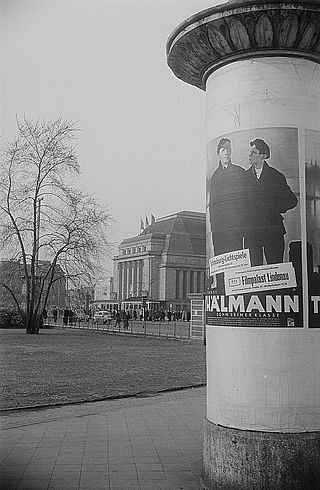
Gustav von Wangenheim was a German actor, screenwriter and director.

Ernst Thälmann is an East German film in two parts about the life of Ernst Thälmann, leader of the Communist Party of Germany during much of the Weimar Republic, directed by Kurt Maetzig and starring Günther Simon in the title role. The first part, Ernst Thälmann - Sohn seiner Klasse, was released in 1954. It was followed by the 1955 sequel. Ernst Thälmann - Führer seiner Klasse.

Günther Simon was an East German actor.
Girls in Gingham —sometimes called Beaverskin—is a 1949 German drama film directed by Kurt Maetzig.
Der Auftrag Höglers is a German Democratic Republic fantasy movie directed by Gustav von Wangenheim. It was released in 1950.

Familie Benthin is an East German film. It was released in 1950.
Der Rat der Götter is an East German black-and-white film, directed by Kurt Maetzig. It was released in 1950.

The Call of the Sea or The Oceans Are Calling is a 1951 East German drama film directed by Eduard Kubat and starring Hans Klering, Käte Alving and Evamaria Bath. A defector to West Germany returns to the East, having become disillusioned by capitalist society.
The Kaiser's Lackey is a 1951 East German film directed by Wolfgang Staudte, based on Heinrich Mann's 1918 satirical novel by the same name.
Shadow over the Islands is an East German black-and-white film, directed by Otto Meyer. It was released in 1952.

Berlin, Schoenhauser Corner is an East German crime film directed by Gerhard Klein. It was released in 1957.
Schlösser und Katen is an East German black-and-white film, directed by Kurt Maetzig. It was released in 1957.
Don't Forget My Little Traudel is an East German comedy film, directed by Kurt Maetzig. It was released in 1957.

The Sailor's Song is an East German black-and-white film directed by Kurt Maetzig and Günter Reisch. It was released in 1958.
Love's Confusion is an East German romantic comedy film directed by Slátan Dudow. It was released in 1959.
Zu jeder Stunde is an East German black-and-white film, directed by Heinz Thiel. It was released in 1960.
September Love is an East German film directed by Kurt Maetzig. It was released in 1961.
Sun Seekers is an East German film, directed by Konrad Wolf during 1958. It was banned and subsequently released only in 1972.

The Axe of Wandsbek is a 1951 East German film, directed by Falk Harnack.
Martin Hellberg was a German actor, director and writer.








